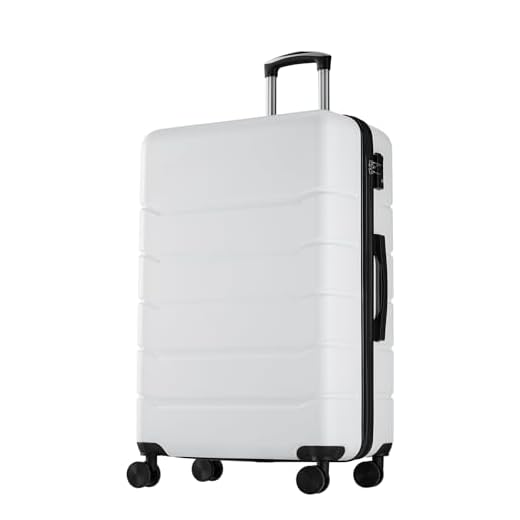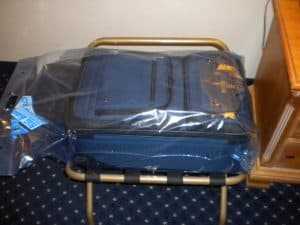



Opt for hard-shell cases made from polycarbonate or ABS plastic. These materials provide a solid barrier, making it difficult for unwanted critters to penetrate. Look for options with tight seals and zippers that close securely to minimize any openings.
This article is designed for travelers who want to safeguard their belongings from unwelcome hitchhikers. It offers insights into various types of travel containers that can help reduce the risk of infestations during your journeys, whether for business or leisure.
Within the text, you’ll find recommendations for specific brands and models known for their pest-resistant features, as well as tips on how to inspect your travel gear before and after trips. Consider the benefits of using vacuum-sealed bags for clothing and packing materials that discourage pests. Understanding these aspects could make your travels more enjoyable and worry-free.
Best Luggage to Prevent Bed Bugs
Choosing the right travel gear can significantly reduce the risk of bringing unwanted critters back home. Opt for hard-shell options that are less likely to harbor pests compared to soft-sided alternatives. The smooth surfaces of hard cases make it challenging for these insects to cling on and are easier to clean.
Additionally, consider suitcases with seamless designs. Avoid bags with external pockets where pests can hide. A design that allows for easy inspection and cleaning is important. Look for options with a tight closure mechanism to minimize entry points.
Materials and Features
When selecting your travel gear, focus on materials that are less inviting to pests. Some effective materials include:
- Polycarbonate: This lightweight and durable material provides a solid barrier against pests.
- Nylon: While not as impenetrable as hard-shell cases, high-denier nylon can be resistant to tears and easier to inspect.
- Water-resistant fabrics: These can help keep moisture out, making your bag less appealing to insects.
In addition to materials, consider the following features:
- Sealed zippers: Ensure that zippers are designed to close tightly, preventing any chance of entry.
- Removable liners: Some cases come with removable liners that can be washed regularly.
- Elevated feet: Keeping your case off the ground can help avoid contact with potential pests.
By selecting the right travel gear and paying attention to design and materials, you can significantly reduce the risk of unwanted guests during your travels.
Choosing Hard-Shell Suitcases for Maximum Protection
Selecting hard-shell cases is a strategic choice for safeguarding belongings against unwanted intruders like insects. These robust containers offer a solid barrier that minimizes the risk of infestations during travel. Their construction prevents tiny pests from easily infiltrating the contents, providing peace of mind for travelers.
The rigid exterior of hard-shell cases not only enhances durability but also aids in maintaining a controlled environment within. This is particularly useful for items like clothing and personal belongings, as the sealed nature reduces the likelihood of pest entry. To maximize protection, ensure that the suitcase features tight-fitting zippers and seamless closures.
Key Features to Consider
- Material Quality: Opt for cases made from high-quality polycarbonate or ABS, as they are less likely to crack or break under pressure.
- Sealed Edges: Look for designs with sealed edges to limit entry points for pests.
- Internal Compartments: Utilize compartments to keep items organized and minimize the risk of cross-contamination.
- Regular Maintenance: Inspect and clean the suitcase after each trip to eliminate any potential hitchhikers.
Incorporating these elements into your selection process enhances the effectiveness of hard-shell cases as a protective measure against pests. Investing in sturdy, well-designed cases not only safeguards your belongings but also contributes to a more enjoyable travel experience.
Features to Look for in Bed Bug-Resistant Bags
Choosing the right type of bag can significantly minimize the risk of carrying unwanted pests. Focus on materials and construction that create barriers against these nuisances.
Look for tightly woven fabrics that are resistant to punctures and tears. Such materials can help prevent these insects from infiltrating the bag. Additionally, consider options with sealed zippers, as they offer an extra layer of security compared to traditional zipper designs.
Key Characteristics
- Material Quality: Opt for bags made from high-density synthetic fibers that are less likely to harbor insects.
- Sealed Zipper Design: Ensure that zippers are designed to close completely, leaving no gaps for pests to enter.
- Hard-Shell Options: Consider hard-sided bags that are less penetrable than soft-sided varieties.
- Easy to Clean: Select bags that can be easily wiped down or washed, facilitating regular maintenance.
- Storage Features: Look for compartments that can securely contain smaller items, reducing the likelihood of pests spreading.
Be sure to check for any certifications or testing that confirm the bag’s effectiveness against unwanted insects. Some manufacturers may provide information on how their products have been evaluated for pest resistance.
Investing in a bag with these features not only protects personal belongings but also contributes to a more comfortable travel experience.
Best Practices for Packing to Avoid Infestation
Utilize sealable plastic bags for clothing and personal items. This method creates a barrier, minimizing the risk of unwanted pests entering your belongings. Ensure to double-bag items if you are particularly concerned about exposure.
Before packing, inspect your items for any signs of infestation. This includes checking seams and folds in fabrics, as these areas can harbor hidden intruders. Also, consider washing and drying your clothes at high temperatures to eliminate potential threats.
Storage and Packing Techniques
Employ the following strategies during your packing process:
- Keep garments in airtight containers: This limits exposure to potential contamination.
- Use hard-shell cases: Unlike soft-sided varieties, they do not provide easy access for pests.
- Separate clean and dirty items: Store worn clothes in a separate bag to avoid cross-contamination.
- Limit soft furnishings: Items like pillows or blankets can be more susceptible to infestations.
Upon arrival at your destination, immediately inspect the area where you will stay. Consider placing your bags on hard surfaces rather than on beds or upholstered furniture.
If you’re traveling frequently, develop a routine for inspecting your belongings after each trip. This proactive approach can help to identify any issues before they escalate.
Brands Known for Bed Bug Prevention Solutions
Investing in a reliable solution for travel can significantly reduce the risks associated with unwanted pests. Several manufacturers have developed products focusing on this specific issue, ensuring that users can travel with peace of mind. Their offerings include specialized materials and designs aimed at deterring infestations.
Many recognized companies have tailored their products to provide enhanced protection. Key features often include sealed compartments, protective linings, and materials treated with specific insect-repelling agents. These innovations are designed to create a barrier between users’ belongings and potential threats, making them a preferred choice for those concerned about unwanted hitchhikers.
Highlighted Features and Innovations
- Innovative Materials: Many brands utilize fabrics that are dense enough to prevent insects from penetrating while remaining lightweight for convenience.
- Sealed Zippers: Products equipped with specially designed zippers that prevent any entry points for pests.
- Internal Organization: Clever compartment designs that minimize clutter, making it easier to keep items contained and organized.
- Washable Components: Some offerings include washable elements, allowing for easy maintenance and cleanliness.
It’s beneficial to research and compare various manufacturers to identify options that best suit individual travel needs. Reading user reviews can provide insights into the effectiveness of these protective solutions in real-world scenarios. Ultimately, making an informed decision can lead to a more enjoyable and worry-free travel experience.
Travel Tips to Minimize Bed Bug Exposure
Always inspect accommodations thoroughly upon arrival. Check the mattress seams, headboard, and surrounding furniture for any signs of these pests. If you notice any evidence, request a different room or find alternative lodging immediately.
Keep your belongings organized and contained. Use hard-shell cases or zippered bags to minimize the chance of contamination. When possible, keep your items off the floor and furniture by using luggage racks or placing bags in the bathtub.
Preventive Measures During Travel
- Wash and dry clothes on high heat after returning home to eliminate any unwanted hitchhikers.
- Store your belongings in plastic bags while traveling to create an additional barrier.
- Be cautious when using shared laundry facilities and inspect machines before use.
Awareness is key. Stay informed about recent outbreaks in your travel destinations, and consider using protective covers on your bedding if you suspect an infestation.
- Check for signs of infestation:
- Rusty or dark spots on sheets and mattress.
- Small, shed skins or eggs.
- Unpleasant, musty odor.
- Keep travel gear elevated and away from potential infested areas.
- Limit the use of second-hand items during travels.
Implementing these strategies can significantly reduce the risk of an unwelcome encounter with these pests while traveling.
Best luggage to prevent bed bugs
Features
| Part Number | 78255-1508 |
| Model | 78255-1508 |
| Color | Light Grey |
| Size | Carry-on Spinner |
Features
| Part Number | GRSWT-2LG-24WT |
| Model | GRSWT-2LG-24WT |
| Color | Cream White |
| Size | 24 Inch |
Video:
FAQ:
What features should I look for in luggage to prevent bed bugs?
When choosing luggage that helps prevent bed bugs, consider options made from hard-sided materials. These types of suitcases are less likely to harbor bugs compared to soft-sided bags. Look for luggage with a seamless design, as fewer seams mean fewer hiding spots for pests. Additionally, check for zippers that can be securely closed, and consider bags with lockable zippers to deter any unwanted access. Another helpful feature is the ability to store luggage off the ground, such as luggage with built-in stands or elevated designs. Finally, think about using luggage that has a durable finish, which can contribute to easier cleaning if bed bugs are a concern.
How can I ensure my luggage is bed bug-proof during travel?
To keep your luggage safe from bed bugs while traveling, start by inspecting your luggage before and after each trip. When you arrive at your accommodation, place your bags on a luggage rack rather than on the bed or floor. This reduces the risk of bed bugs transferring from surfaces to your luggage. Additionally, keep your belongings in sealed plastic bags within your suitcase to create an extra barrier. When packing, avoid bringing items such as bed linens or pillows from the hotel into your luggage, as these can harbor bed bugs. After your trip, wash your clothes in hot water and dry them on high heat, as this can kill any bugs that may have hitched a ride. Regularly vacuum and inspect your luggage at home to ensure it remains bed bug-free.







